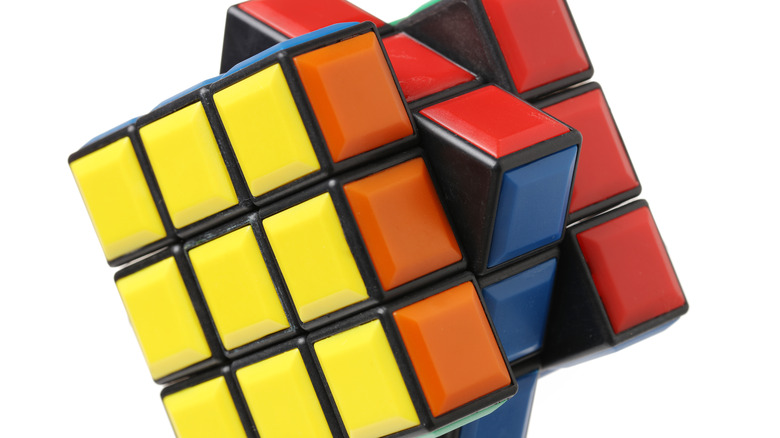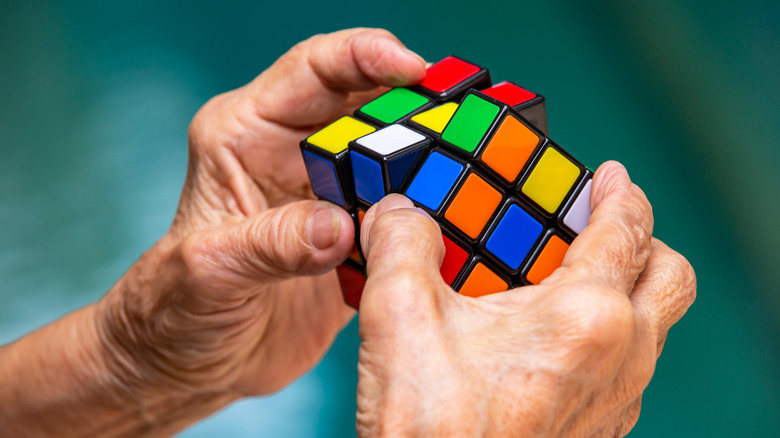The Real Reason Rubik's Cubes Were Invented
Every decade has produced its bits of pop-culture nostalgia. The Hula Hoop was big in the 1950s, the Tamagotchi was all the rage in the 1990s, the 1970s saw the Pet Rock, of all things. Perhaps no bit of physical nostalgia — which is to say, something you can hold in your hands — to come out of the 1980s is the Rubik's Cube. Though it's forever associated with 1980s nostalgia, the toy, which as of 2009 had sold more than 350 million units worldwide (according to Time), was actually invented back in 1974, according to the Smithsonian.
At the time, the toy's inventor, Hungarian mathematician Ernő Rubik, wasn't interested in making a toy that would bedevil its users, start a whole new industry of knockoffs and books teaching how to solve it, and make the professor tens of millions of dollars. Rather, as Smithsonian explains, Rubik's original invention — which bears only a superficial resemblance to the product pictured above, was intended as a teaching aid, to teach Rubik's students about complicated concepts. Or maybe he really was all about making a toy; there's some dispute about that.
A Teaching Aid?
Back in the middle 1970s, Ernő Rubik (pictured above) was a professor at Budapest University of Technology, College of Applied Arts, according to The New York Times. One of his classes involved what Rubik called "descriptive geometry," which is to say, understanding the relationship between two-dimensional and three-dimensional shapes, a concept that has applications in architecture, design, and engineering, among other fields.
As Smithsonian Magazine explains, Rubik wanted a physical device that he could use as a teaching aid to explain three-dimensional movement to his students. Using wooden blocks, he eventually cobbled together a device "made from wood and paper, held by rubber bands, glue, and paper clips." He named it "Bűvös kocka," or Magic Cube.
Although the narrative put forward by Smithsonian is that the professor designed the cube strictly as a teaching aid and not as a toy, the Museum of Play claims otherwise. Specifically, the website claims that Rubik himself later admitted that intentionally set out to design a geometry-based puzzle.
From The Classroom To The Toy Box
In 1977, a few years after he cobbled together his "Magic Cube" in a university wood shop, Rubik, realizing he had a winner on his hands, and applied for a patent, according to the Smithsonian. A few phone calls, visits to toy symposiums, and deals later, and the Ideal Toy Company was producing the version of the Rubik's Cube we all know and love — plastic instead of wood, with colorful squares, as Smithsonian Magazine notes. The rest, as they say, is history.
The first person to solve the Rubik's Cube was, perhaps unsurprisingly, Rubik himself. It was not easy. At the time, there were no online tutorials or books about how to solve it, and he was on his own. "[It was extremely difficult] to find your way back, or to find your target — just to solve it as a combinatorical problem. And I was without any background for that, because I was the first who tried," he said. It took him a month, but eventually he got there. When he finally solved it, according to The New York Times, he felt "a great sense of accomplishment and utter relief."
These days, Rubik's Cubes are routinely solved not in weeks, but in seconds. For example, this video shows a solver completing the puzzle in mere seconds.


